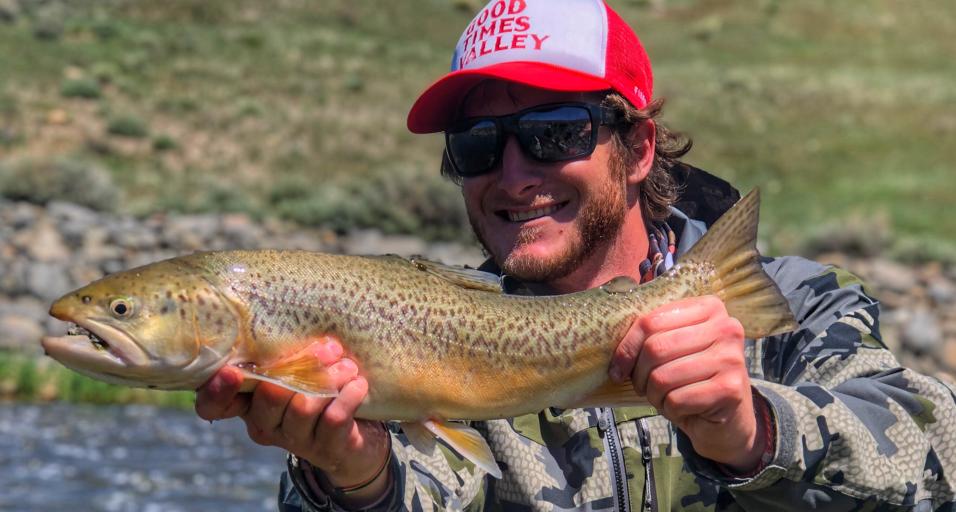Tiger trout are a unique, relative newcomer to the Cowboy state. Recently at the Story Hatchery we've have been asked, how are these fish produced and where can I go to catch one of these feisty and colorful fish?The Story Hatchery began producing tiger trout eggs in the fall of 2011. For those unfamiliar with these hybrid fish, a tiger trout egg is produced by crossing a female brown trout with a male brook trout. The cross is completed with a female brown trout as attempts using a female brook trout by a male brown trout did not work very well and produced significantly lower quality eggs. One thing many people don’t know about tiger trout is that they are sterile and are unable to reproduce. How do we know these fish are unable to reproduce? Well, the Story Hatchery creates what is called a triploid egg.
A triploid fish has three sets of chromosomes, unlike a fertile fish that have two set of chromosomes (a diploid fish). A triploid fish is not a genetically modified organism nor have the genes of the fish been manipulated or modified in any way. Triploid fish simply have an extra copy of DNA that makes reproduction impossible.
Triploid tiger trout are created by forcing the egg to retain a chromosome that is normally ejected during egg development. To prevent the egg from rejecting the chromosome, Story Hatchery personnel use a pressure treatment method to retain the chromosome that would normally be kicked out of the egg during an early stage of egg development. Using pressure, at precisely the right time in the egg development, the chromosome is retained; resulting in a sterile fish with three chromosomes.The Story Hatchery uses a small pressure chamber to induce triploidy in the eggs. After the eggs from the female and milt from the male are mixed to fertilize the eggs, the group of eggs is left to develop for 40 minutes. At exactly 40 minutes post fertilization, the group of eggs are placed into the chamber and are subjected to 9,500 psi of pressure for five minutes. Previous studies have found that it is during this five minute period at 40 minutes post fertilization the third chromosome is kicked out of the egg. By applying pressure during that exact time, the hatchery is able to produce triploid eggs.
The triploid process actually produces more viable tiger trout eggs than if we left them as diploid eggs. Hatchery personnel are unable to explain why inducing triploidy in tiger trout eggs creates more viable and successful eggs, but studies have proven that it does.
In 2013, the Story Hatchery conducted its own experiment to compare survivability of diploid versus triploid tiger trout eggs. Hatchery personnel found that 72% of the triploid eggs survived from the time the eggs were taken until the fish started to feed whereas only 54% of the diploid eggs survived until the fish started feeding. The quality of eggs produced by the Story Hatchery have become so highly regarded that they are shipped to the states of Nebraska, South Dakota, Colorado, Idaho, and Oregon as part of the Game and Fish’s hatchery trading program that brings walleye, catfish, and other species back into Wyoming.
Now you have somewhat of an understanding of the tiger trout making process. Why are we stocking these fish in the first place and where can you go to catch this unique species in the Sheridan area? Since tiger trout are sterile, they tend to put all of their energy into growth and since they won’t reproduce, we stock them in places to act as a biological control. These are situations where we have stunted, overabundant populations of other species; sometimes undesirable species like suckers, but also brook trout and grayling. In the Sheridan Region we have stocked tiger trout in Willow Park, Cloud Peak, Weston, and Muddy Guard reservoirs #1 and #2, and Long and Ringbone lakes in the Cloud Peak Wilderness. The stocking of tiger trout is still a relatively new tool for us and we are still evaluating their effectiveness as a biological control in these waters. Nonetheless, tiger trout are very aggressive, they fight hard, and they have created a little excitement with our angling public.
--
By Steve Diekema, Story Hatchery Superintendent. This was first printed in the 2019 Sheridan Region Angler newsletter. Read the full newsletter online.
Making tiger trout

